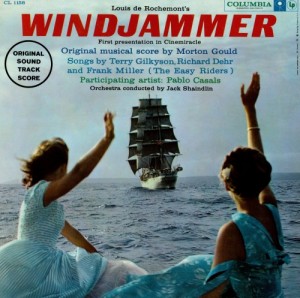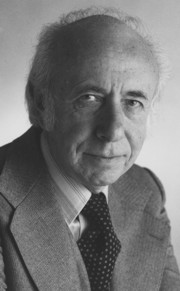A Stately Roll
Theme Songs Page | Previous Theme Song| Next Theme Song
A Stately Roll

Windjammer (The Ship) by Morton Gould (1958), Encountered 1960
I had the rare good luck to be raised by two loving parents and two loving step-parents, and I loved all of them back. Each of them, whatever their flaws might have been, was unambiguously my loyal supporter. A young man can ask for few better things. I believe that in consequence my experience of what they called in that era a “broken home” was about as painless as it is ever possible for that kind of thing to be.
But that is not to say that there wasn’t some pain involved, or that all of the foursome could participate equally in my life. My mom and stepfather were the custodial parents, and my home was with them in Ann Arbor, Michigan, which lies about 40 miles to the west of Detroit. For some reason we never visited Detroit as a family. My father lived in New York, and of course tried to make a big occasion of it every time he visited with me. The biggest occasions in the neighborhood frequently were to be found in Detroit. Hence it was with my dad, not my mom and stepdad, that I received most of my experiences of the car-making metropolis to the east.
Thus I had some very good feelings about Detroit simply owing to the fact that my dad took me there – and made a fuss over me there. You’d expect, and you’d be correct, that music associated with such visits might resonate with me.
For instance, on one Saturday in October of 1960,[1] my father flew into Willow Run airport where I was waiting for him and from whence we traveled into Detroit, stayed at the large and swanky Park Shelton Hotel,[2] and made an evening of it by going to the grand art deco Music Hall Theatre[3] and seeing Windjammer.
Windjammer was the one and only feature movie made in Cinemiracle, a rival process to Cinerama. I recognize that neither name may mean much over 50 years later. Each technology involved filming with three cameras and exhibiting with three projectors. With all that square footage of celluloid, the resulting image could be huge. The screen was designed to wrap around its audience (similar to IMAX today, but more so). The idea was to give the viewer the sense of being in the midst of the action.
Despite the technical imperfections of the processes (join lines where the pictures bordered being probably the worst), Cinerama/Cinemiracle did have the uncanny power of putting you in the middle of things. So far as I am aware, there was never a truly great movie made by either process, but the depiction of certain things like roller coaster rides or buffalo stampedes would be so awe-inspiring, no one was going to be carping at the mere absence of great art.
Windjammer in particular, which had its U.S. premiere in April of 1958, follows the men and boys of the Christian Radich, a Norwegian tall ship used as a training vessel for that nation’s merchant marine. They have adventures like a squall in the Bay of Biscay, attending a private cello recital by Pablo Casals, riding basket sleds in Madeira, and experiencing the bright lights of New York City. I had a riotous time, and came out with my eleven year-old brain intoxicated by the wild spectacle. My father, who was always one to make the flavor last when he could, bought me the LP on the way out the door, where it was on sale.
When I got back to Ann Arbor, that record promptly became one of my favorites, and not merely because of the associations I’ve mentioned.
I still have it. It is a musical potpourri doubtless designed to appeal to a wide variety of tastes: not only the aforementioned Casals track, but also some purpose-composed “easy listening” ballads allegedly sung spontaneously by the crewmen, a couple of dollops of Caribbean steel band, and regular film score music. The latter was composed by Morton Gould, a remarkable American composer comfortable as Leonard Bernstein writing in popular genres but just as clearly capable of working in the classical tradition.[4] I think I recognized immediately the difference between the quality of the hackwork on the “spontaneous” songs of the crew and the haunting melodies and orchestration that emanated from Gould.
The gem of the album is the ship’s own theme song, Windjammer (The Ship), which somehow captures the stately roll of a powerful rigged vessel, and conveys a sense of the adventures two which such a vessel is capable of bearing its crew.
Listening to it carefully now, I can sort of see how Gould does it. There are two themes playing against each other for most of the song. To oversimplify a lot (because I’m not a trained musician nor do I want to do a real blow-by-blow of it) here’s what I hear. There’s a rolling theme, usually articulated by the strings, in upward and downward arpeggios, mainly inversions of the tonic (D) chord dropping down to the minor and then springing back. Over and separate from that background, there’s a melody, carried originally by the strings, later mostly by the brass, that sounds all at once wistful and questing, ending up on the subdominant, with the tonic note emphasized. The whole thing is flavored with harps, cymbals, and nautical-sounding bells. After about a minute of this, the brass starts coming in and making everything sound bolder and more adventurous. Toward the end, the brass even takes over the job of doing the arpeggios for a bit. There are quiet bridge sections and a key change dropped in here and there to help the listener catch his/her breath, but it always comes back even louder and bolder than before, building to a big crescendo at the end, tailing off into quietness in the last couple of seconds, with another nautical bell. This ravishing little package, about three and a quarter minutes’ worth, would make anyone fantasize about going to sea.
In a way, the outlandishness of it, especially in the great Midwest, was the point for me. I could not see myself as a seafarer. Though I’d crossed the ocean three times by my 12th year, I understood without having to be told that this experience had little in common with actual sailing. And I was okay with that. But if I was not looking for sea adventures, I was looking for adventures of some kind, and the music spoke to that too.
Getting taken to fancy hotels and movie houses by my dad was a pretty good start.
I didn’t know exactly what I was headed for, but this music helped me feel pretty good about my prospects of having stirring times along the way. I hummed it a lot for a while.
[1]. Saturday, October 29, 1960 to be specific. My thanks to my friend Walter Hogan, Technical Services Coordinator at Eastern Michigan University Library, who did the necessary research to confirm the date.
[2]. That swanky hotel has had various owners and names over the years, and is now condominiums but that was the name then.
[3]. The Music Hall was the Cinerama theater in Detroit, and, though, as discussed below, Windjammer was in Cinemiracle, Windjammer was shown in the same venue. I understand (again thanks to my friend Walter Hogan’s research), that Windjammer opened there in March of 1960; I’m guessing it had to wait for a window of opportunity amongst competing Cinerama productions. This explains why I saw the movie over two years after it premiered.
[4]. In fact I’d make so bold as to say that in his New York number, part of the Windjammer score, Gould was “quoting” Bernstein’s Ballet at the Village Vortex which had been part of the score of the musical Wonderful Town (1953) and some of the sequences in Bernstein’s On The Town (1944). To the mid-century ear, Bernstein had sort of set the pattern for what the musical evocation of New York sounded like, but Gould worked easily and with comparative originality within that pattern.
Copyright (c) Jack L. B. Gohn, except for album art
